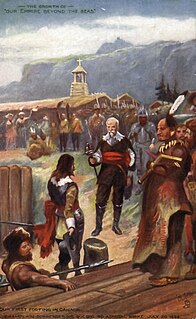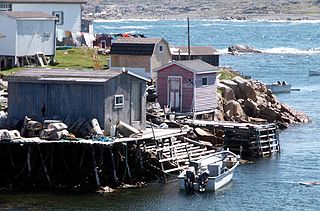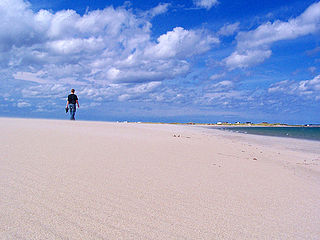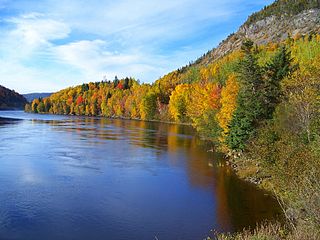
Newfoundland and Labrador is the most easterly province of Canada. Situated in the country's Atlantic region, it comprises the island of Newfoundland and mainland Labrador to the northwest, with a combined area of 405,212 square kilometres (156,500 sq mi). In 2018, the province's population was estimated at 525,073. About 92% of the province's population lives on the island of Newfoundland, of whom more than half live on the Avalon Peninsula.

Fogo Island is the largest of the offshore islands of Newfoundland and Labrador, Canada. It lies off the northeast coast of Newfoundland, northwest of Musgrave Harbour across Hamilton Sound, just east of the Change Islands. The island is about 25 km long and 14 km wide. The total area is 237.71 km2 (91.78 sq mi).

Bonavista is a town on the Bonavista Peninsula, Newfoundland in the Canadian province of Newfoundland and Labrador. Unlike many Newfoundland coastal settlements, Bonavista was built on an open plain, not in a steep cove, and thus had room to expand to its current area of 31.5 square kilometres.

The Province of Avalon was the area around the settlement of Ferryland, Newfoundland and Labrador, in the 17th century, which upon the success of the colony grew to include the land held by Sir William Vaughan and all the land that lay between Ferryland and Petty Harbour.

Sir David Kirke was an adventurer, colonizer and governor for the king of England. He is best known for his successful capture of New France in 1629 during the Thirty Years' War and his subsequent governorship of lands in Newfoundland. A favourite of Charles I of England, the fall of the Crown during the English Civil War led to Kirke's downfall. It is believed he died in prison.

Lawn, population approximately 670 as of 2011, is located at the tip of the Burin Peninsula on Newfoundland's South coast, Newfoundland and Labrador. Lawn is spread around a small harbour in a relatively lush valley. According to one local tradition it was this lushness that inspired Captain James Cook to name the place Lawn Harbour. But it has also been speculated that a Frenchman named the community after a doe caribou that he spotted there.

An outport is the term given for a small isolated coastal community in the Canadian province of Newfoundland and Labrador. Originally the term was just used for coastal communities on the island of Newfoundland but the term has also been adopted for those on the mainland area of Labrador as well.
The History of Saint Pierre and Miquelon is one of early settlement by Europeans taking advantage of the rich fishing grounds near Saint-Pierre and Miquelon, and is characterized by periods of conflict between the French and British.

Conche is a community on the Northern Peninsula of Newfoundland and Labrador, Canada. Its population in 2016 was 170.

Petty Harbour–Maddox Cove is a town of approximately 960 people located on the eastern shore of the Avalon Peninsula in the province of Newfoundland and Labrador, Canada. It is nestled deep in the heart of Motion Bay, just south of St. John's. The present town is approximately 200 years old, though the site has been continuously occupied since at least 1598, predating the arrival of the Mayflower and making it one of the oldest European settlements in North America. During King William's War, the village was raided by Canadiens in the Avalon Peninsula Campaign.

Virgin Arm–Carter's Cove is a designated place located on New World Island in the Canadian province of Newfoundland and Labrador. The area had a population of 616 in the Canada 2006 Census.

A fishing stage is a wooden vernacular building, typical of the rough traditional buildings associated with the cod fishery in Newfoundland, Canada. Stages are located at the water's edge or "landwash", and consist of an elevated platform on the shore with working tables and sheds at which fish are landed and processed for salting and drying. Traditionally, they are painted with a red ochre paint, though colours other than red are sometimes seen.
The stage is unique among British and North American outbuildings because unlike the typical uses of agricultural structures, both the slaughter and the processing of a harvested animal takes place within this space. While barns and stables were intended for year-round housing of live animals, the stage would be used only for several months during the summer, and not as a shelter for livestock.
The first brief European contact with Newfoundland and Labrador came about 1000 AD when the Vikings briefly settled in L'Anse aux Meadows. Around 1500, European explorers and fishermen from England, Portugal, Netherlands, France, and Spain began exploration. Fishing expeditions came seasonally; the first small permanent settlements appeared around 1630. Catholic-Protestant religious tensions were high but mellowed after 1860. The British colony voted against joining Canada in 1869 and became an independent dominion in the early 20th century. Fishing was always the dominant industry, but the economy collapsed in the Great Depression of the 1930s and the people voluntarily relinquished their independence to become a British colony again. Prosperity and self-confidence returned during the Second World War, and after intense debate the people voted to join Canada in 1949.

Nipper's Harbour, a community located on the east coast of the Baie Verte Peninsula in the Province of Newfoundland & Labrador, Canada. This incorporated community of 85 people is located on a rocky inlet that combines Nipper's Harbour and Noble's Cove, and where the primary industry is the inshore fishery.

The community of Lumsden, formerly known as Cat Harbour, is located on the Straight Shore of Newfoundland and Labrador near communities such as Musgrave Harbour and Newtown. Lumsden was formerly made up of two settlements, Lumsden North on the tip of a sandy peninsula and Lumsden South on the main road. Although the harbour in Lumsden is not ideal because it is not sheltered, Lumsden has excellent fishing grounds.

Port au Choix or Port aux Choix is a town in the Canadian province of Newfoundland and Labrador.
The Fish, Food and Allied Workers (FFAW) Union is a trade union in Newfoundland and Labrador that represents 20,000 workers. Most of the members are in the fishing industry but the FFAW also has organized workers in the hotel, hospitality, brewing, metal fabrication, window manufacturing and oil industries in the province. The FFAW is the largest private sector union in Newfoundland and is affiliated with the Canadian Auto Workers union.

Cod fishing in Newfoundland was carried out at a subsistence level for centuries, but large scale fishing began shortly after the European discovery of the North American continent in 1492, with the waters being found to be preternaturally plentiful, and ended after intense overfishing with the collapse of the fisheries in 1992.

Cod fisheries are fisheries for cod. Cod is the common name for fish of the genus Gadus, belonging to the family Gadidae, and this article is confined to the three species that belong to this genus: the Atlantic cod, the Pacific cod and the Greenland cod.

Newfoundland is a large Canadian island off the east coast of the North American mainland, and the most populous part of the Canadian province of Newfoundland and Labrador. It has 29 percent of the province's land area. The island is separated from the Labrador Peninsula by the Strait of Belle Isle and from Cape Breton Island by the Cabot Strait. It blocks the mouth of the Saint Lawrence River, creating the Gulf of Saint Lawrence, the world's largest estuary. Newfoundland's nearest neighbour is the French overseas community of Saint-Pierre and Miquelon.




















